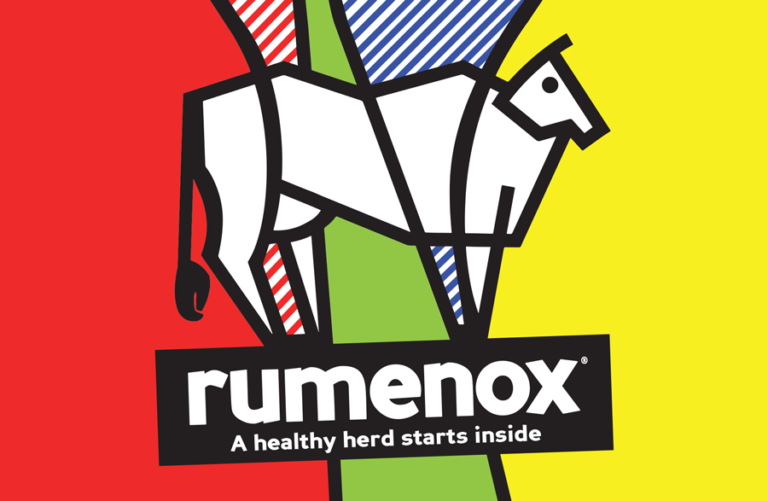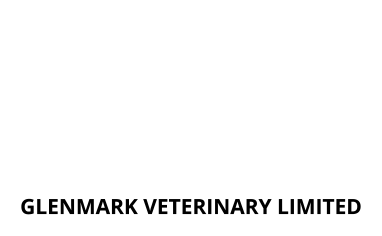causes, symptoms, diagnosis, and treatment
Ketosis is a common metabolic disease that affects New Zealand dairy cows, particularly during early lactation. It occurs when cows experience a severe negative energy balance, where the demand for energy exceeds their feed intake, causing the cow’s body to mobilise fat reserves. These reserves are broken down into ketone bodies, which, when produced in excess, lead to ketosis. While ketosis can be a normal physiological response to energy deficiency, it is not an ideal state for our New Zealand dairy cows, it can also have serious consequences if not properly managed.
This comprehensive guide covers the causes, types, symptoms, diagnosis, prevention, and treatment of ketosis in New Zealand dairy cows.
What is ketosis in dairy cows?
Ketosis in dairy cows is primarily caused by a negative energy balance, particularly during early lactation. At this time, cows are producing large quantities of milk, but their energy intake may not be sufficient to meet the increased demand. As a result, the cow’s body breaks down fat stores for energy, leading to the production of ketone bodies, such as β-hydroxybutyrate (BHB). While small amounts of ketones can be used for energy, when their concentration becomes too high, ketosis develops, leading to clinical symptoms and potential health issues.
Prevalence of subclinical ketosis in New Zealand dairy herds
Subclinical ketosis commonly occurs in early lactation, typically within the first few weeks post-calving, with the highest rate observed in the first two weeks, when cows experience a negative energy balance.
This condition is alarmingly prevalent among dairy cows in New Zealand, with DairyNZ’s 2016 study finding an average of 75% of cows in the sample herds experienced moderate hyperketonaemia ketosis (a diagnostic of subclinical ketosis) at least once in the in the first five weeks of calving (defined as blood BHB levels above 1.2mmol). Another study by Compton et al in 2014 found a 14.3% mean herd-level prevalence of subclinical ketosis at 7-12 days post calving (defined as blood BHB levels above 1.4mmol). Within this same study subclinical ketosis revealed a staggering 7% reduction in 6-week in-calf rates.
75%
14.3%
7%
Types of ketosis
Post-calving ketosis occurs when the cow is mobilising excess body fat to meet the demands of milk production. Cows that are overweight at calving, particularly those with a body condition score (BCS) higher than 5, are more likely to experience ketosis. Overfeeding cows before calving can also increase the risk.s
This form of ketosis occurs when there is an unexpected decrease in energy intake. It can happen due to underfeeding or environmental stressors, such as extreme weather conditions (e.g., snowstorms or floods) that prevent cows from accessing sufficient amounts of dry matter.
This form of ketosis is caused by cows consuming poor-quality silage that has undergone secondary fermentation or poor/declining feed quality. The poor-quality increases the risk of ketosis, as it may not provide adequate nutrients for energy production.
Signs and symptoms of ketosis in dairy cows
Ketosis manifests in two primary forms: wasting and nervous.
Wasting Form
Lethargy
A cow may show reduced energy, with its head down and a lack of activity.
Decreased dry matter intake (DMI)
Cows suffering from ketosis may eat less feed.
Decreased milk production
Ketosis often results in a noticeable drop in milk yield.
Sweet-smelling breath
A key sign of ketosis is the sweet, fruity odor on the cow’s breath, often due to the accumulation of acetone.
Nervous Form
Excitability
Cows may become overly excitable, uncoordinated, or aggressive.
Strange behaviour
Some cows may display odd behaviors such as eating soil, licking fence posts, walking in circles, or standing with their heads raised in a corner.
Diagnosis of ketosis
Diagnosing ketosis requires a combination of clinical signs and laboratory tests. While the clinical signs are crucial, they may not always be visible, especially in subclinical cases.
Blood BHB concentration
- Clinical ketosis: A blood BHB concentration greater than 2 mmol/L indicates clinical ketosis.
- Subclinical ketosis: If BHB levels range between 1.2 and 2.0 mmol/L, the cow is considered to have subclinical ketosis.
However, it’s essential to remember that BHB levels can vary based on the cow’s diet. Cows grazing on pasture typically have higher BHB concentrations than those fed a high-grain diet. In pasture-based systems, subclinical ketosis should not be diagnosed based solely on BHB levels. Instead, additional tests, such as Non-Esterified Fatty Acids (NEFA) and glucose concentrations, should be considered to get a clearer picture of the cow’s metabolic status.
Preventing ketosis
Effective prevention of ketosis requires careful management of the cow’s diet, body condition, and overall health.
The autumn period can be critical and farmers need to ensure their cows are well-conditioned before dry-off. Healthy fat accumulation toward the end of the previous season is important, as general cow condition during lactation – characterised by healthy fat accumulation – can be a vital resource at calving time and during early lactation in the next season.
However, fat accumulation during the dry period often presents a problem. During this period, many of the energy pathways are partially inactive, leading to fat accumulation in or around the organs, particularly the liver. This accumulation can become a significant issue when the cow experiences stress, as the fat can clog the liver – the very organ crucial for producing the energy needed to meet the shortfall.
Maintaining efficient rumen function is essential for meeting the cow’s energy requirements. When the rumen does not digest feed efficiently, the cow cannot meet its energy demands.
Being proactive and managing the risks around ketosis is key, as such using a tool such as Rumenox® significantly reduces the risk around ketosis. Studies consistently show a 40% reduction in the disease. For optimum results, Rumenox® should be introduced pre-calving, or if not practical, it should be administered as soon as the dairy herd returns to the milking platform in early spring.
Feed management
- Ensure Balanced Energy Intake: Provide cows with high-energy rations that meet their nutritional needs, especially during the pre-calving and early lactation periods.
- Manage Feed Allocation: Avoid sudden feed shortages, and allocate pasture and supplementary feeds effectively. If pasture is limited, gradually introduce the feed deficit to prevent sudden drops in intake.
- Quality Silage: Ensure that the silage fed to cows is of high quality and free from excessive fermentation. Poor-quality silage increases the risk of ketosis.
Body condition management
- Monitor Body Condition Score (BCS): Keep cows at optimal BCS levels—around 5.0 for mixed-aged cows and 5.5 for heifers. Cows that are too fat at calving are at a higher risk of ketosis.
- Transition Period Care: Cows in the transition period (2-3 weeks before and after calving) are more susceptible to ketosis. Pay attention to their diet and feed allocation during this critical period.
Treatment of ketosis
Rumenox® is proven to tool as an aid in the control of ketosis, helping a cow’s rumen function better, adjusting fermentation to a level more beneficial to the overall health of the cow. With rumen function in balance, cows are less likely to be affected by ketosis. In fact, Rumenox® is so adept at combatting ketosis, that it reduces the risk by 40%.
Other treatment options of sub-clinical & clinical ketosis
While subclinical ketosis may not present overt symptoms, it can still impact milk production and reproduction.
Treating cows with elevated BHB levels could reduce BHB concentrations and improve metabolic status.
If a cow shows clear signs of clinical ketosis, seek veterinary help.
Other treatment may include:
Oral Drenches:
Provide glucose precursors such as monopropylene glycol to boost the cow’s energy levels. This can help increase blood glucose and decrease ketone production.
Intravenous Glucose:
In severe cases, veterinarians may administer intravenous glucose solutions to rapidly increase the cow’s energy levels.
Metabolic Solutions:
Intravenous solutions containing glucose, calcium, magnesium, and phosphorus can be used to treat severe ketosis.
Conclusion
Ketosis is a significant metabolic disorder that can affect dairy cows, especially during early lactation. By understanding its causes, types, and symptoms, as well as implementing effective prevention and treatment strategies, farmers can minimize the risk of ketosis and improve their cows’ health and productivity. Key prevention strategies include managing body condition, ensuring adequate energy intake, and avoiding sudden changes in the diet. If ketosis is suspected, it’s essential to consult with a veterinarian for proper diagnosis and treatment. With proactive management, ketosis can be effectively controlled, ensuring healthier cows and more profitable dairy operations.
Share:
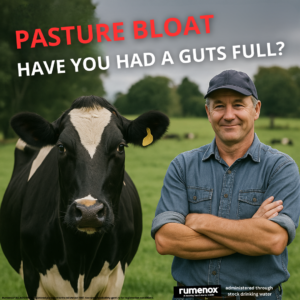
Pasture Bloat – Losing just one cow can cost over $6,000
Pasture bloat is one of the costliest diseases that face the NZ dairy industry. Even with only a small number of cases, a combination of
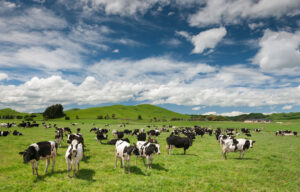
Understanding ketosis in New Zealand dairy cows: causes, symptoms, diagnosis, and treatment
Ketosis is a common metabolic disease that affects New Zealand dairy cows, particularly during early lactation. Learn about ketosis and how to treat it.
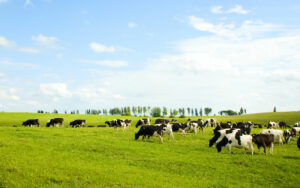
Monensin. The active ingredient in Rumenox.
Rumenox® is the market leading form of monensin in New Zealand. It is available in two forms
